Klarus GL4 Rail Light Review
2022-07-20 :: Tim McMahon
#flashlight #torch #review #Klarus #hunting #tactical
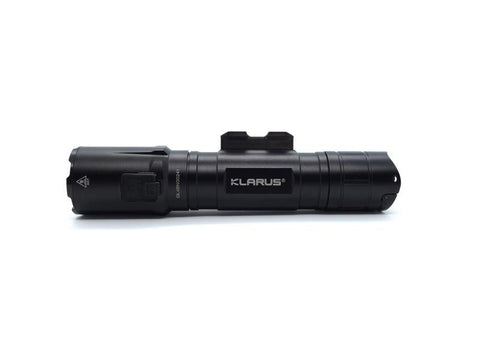
KLARUS GL4 Rail Light
- Specifications
- Introduction
- Torch in use
- Build quality
- LED, bezel, lens, reflector and beam
- Size
- User interface and driver
- Batteries and charging
- Performance
- Beamshots
- Conclusion
- Product page
Specifications
|
Brand/model |
KLARUS GL4 |
|
LED |
Luminus SST-70-WCS-H50-LB (BA) 6500K |
|
Maximum lumens |
3,300 lm |
|
Maximum beam intensity |
34,240 cd |
|
Maximum throw |
370 m |
|
Battery |
1*21700 Li-ion |
|
Onboard charging |
Yes. USB-C. |
|
Material |
Aluminium |
|
Modes |
4 |
|
Blinkies |
Strobe |
|
Reflector |
Smooth |
|
Waterproof |
IPX8 |
|
Review date |
July 2022 |
Introduction
I noticed that liteshop.com.au had asked on their Facebook page whether anyone would be interested in reviewing the KLARUS GL4 Rail Light a few weeks ago. I put my hand up to provide a review after reading about KLARUS’ excellent build quality from a 1lumen review.
KLARUS has been around since 2011 and do their own R&D and manufacturing. They are known for their dual-switch tactical torches and supply law enforcement, military and outdoor enthusiasts.
The KLARUS GL4 Rail Light is intended to be attached to a rail that you may commonly find on firearms used by law enforcement or the military. However, in Australia you may find that rifles with two swivel studs on the stock are commonly used by hunters. Torches are usually mounted to a scope using a clamp. I could use this torch in a scope clamp but I bought a swivel stud to picatinny rail adapter separately to see what that would be like.
liteshop.com.au provided this torch for free to review. I have not been paid for this review nor have I held back my opinions. Thank you liteshop.com.au!
Packaging
The KLARUS GL4 came in a sturdy white retail box with a picture of the torch on the front and specifications on the sides.
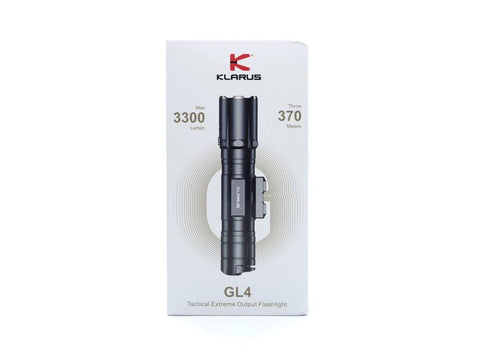
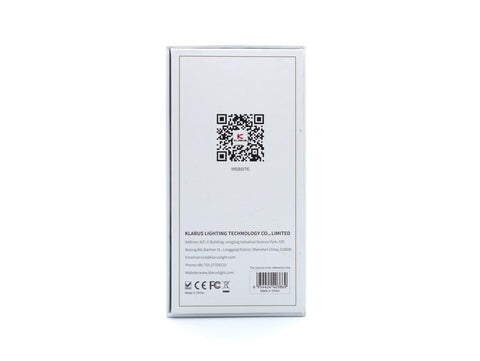

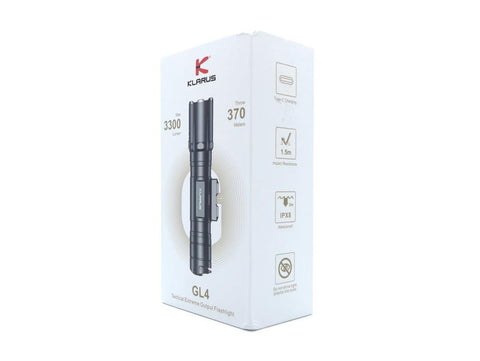
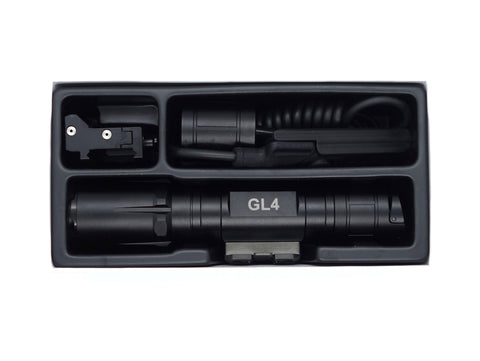
The following was included in the box:
- KLARUS GL4 Rail Light
- KLARUS 21GT-50 21700 5000mAh Li-on battery
- Remote switch
- Picatinny rail adapter
- USB-A to USB-C cable
- Hex wrench
- 2 x Screws
- Spare O-ring
- User manual
The hex wrench, spare o-ring, screws and user manual were hidden under the tray. The tray lifts out!
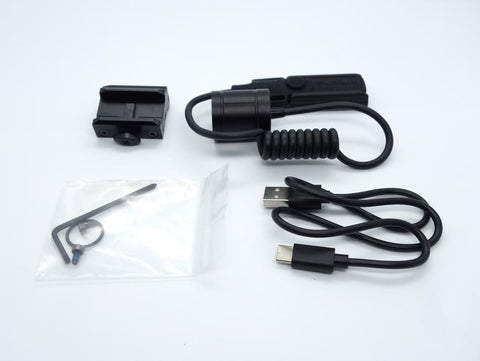

Torch in use
I attached a swivel stud to picatinny rail adapter to a rifle. The adapter that I used was not very adjustable so the torch was fixed in one particular angle. Luckily the beam pointed in the right direction!
A rail adapter for the torch required a hex wrench to loosen two screws so that the adapter could slip over the picatinny rail. Once the adapter was on, I tightened the two screws.
The torch has a notch on the side that slides into either the bottom or the side of the rail adapter. It makes a satisfying click when it has been locked into place. There is a quick release knob to allow the torch to be pulled out.
The included remote switch has two holes to tie it to a rifle. The remote switch came with a plastic rail adapter but I ran out of rails to attach things to. I used a cable tie to tie the remote switch to the stock of the rifle.
The torch can be used without a firearm. The notch on the side of the torch is uncomfortable to hold but it can be unscrewed and removed. The torch will not tailstand due to the angle of the tailcap. There are two holes in the tailcap that could be used with a lanyard. However, a lanyard was not included.
A matte finish gives the torch a bit of extra grip but it is a bit slippery.
The charging cover feels strong and pushes back in securely.

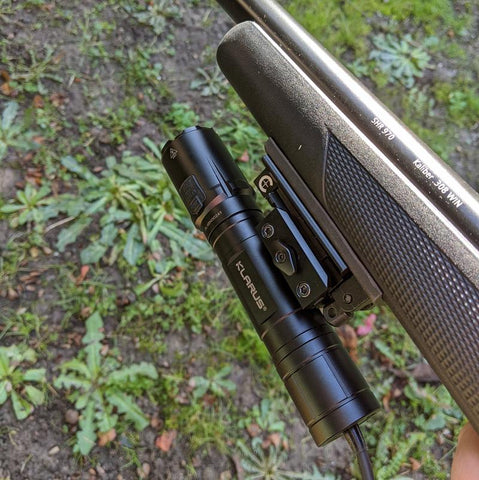
Build quality
The KLARUS GL4 has a lightweight aluminium body with a matte black finish. The only sharp edges that I noticed were on the notch that slides into the rail adapter.
The torch balances well when there is a 21700 battery inside it.
Threads for the tube and tailcap are smooth and came lubricated with what appears to be white grease.
Buttons on the tailcap make loud clicking sounds and look durable. The Main switch has a cute gun reticle design. The Mode switch has three circles for extra grip but it does rattle.
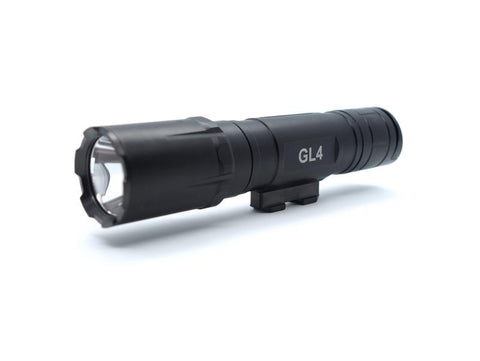
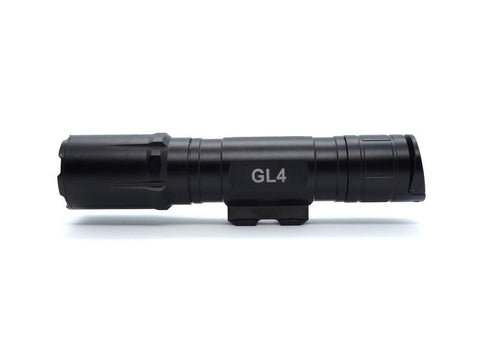
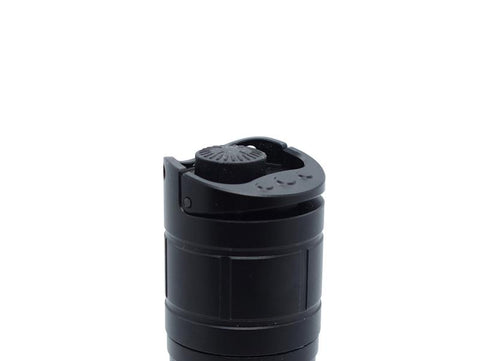
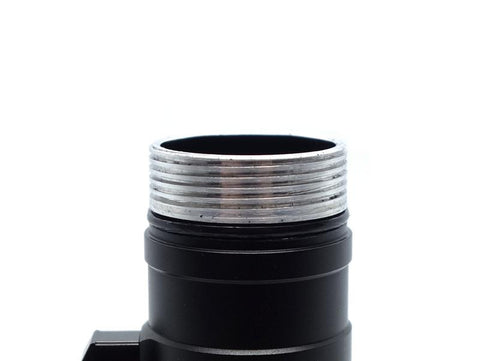
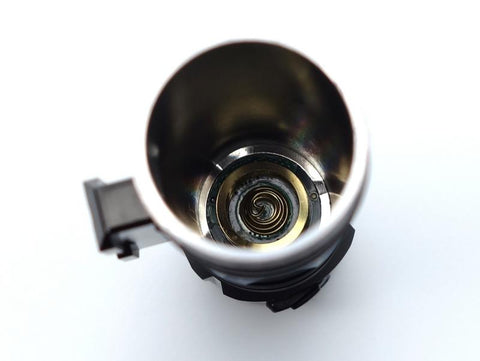

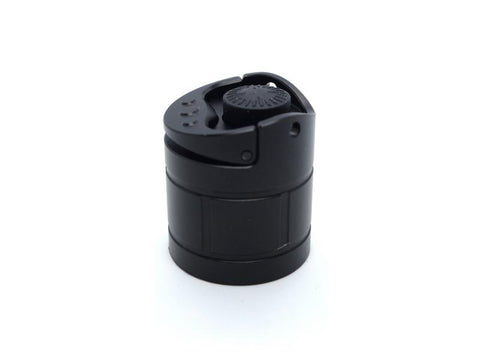
LED, bezel, lens, reflector and beam
The KLARUS GL4 has one Luminus SST-70-WCS-H50-LB (BA) 6500K LED and a smooth reflector.
The bezel gives the torch a tactical look and feel but it is not very sharp.
The glass lens does not appear to have an anti-reflective coating.
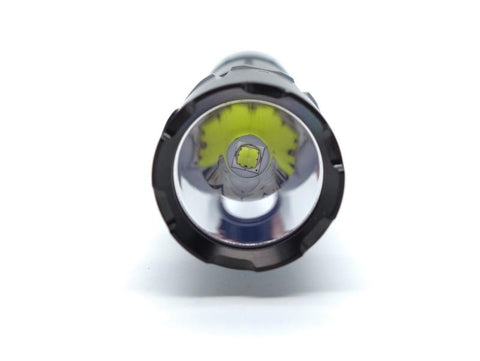
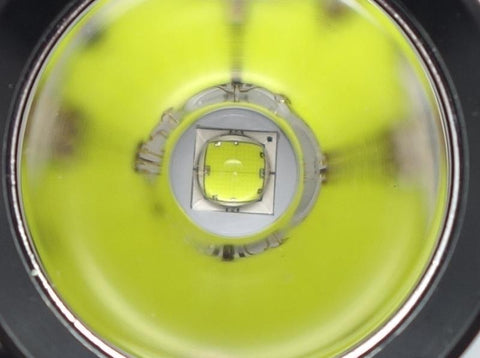
I have taken Correlated Colour Temperature (CCT) and Colour Rendering Index (CRI, RA of R1-R8) measurements with the KLARUS GL4 positioned a little over one metre away from an Opple Light Master Pro III (G3).
The CCT measured is about 5500K and the CRI is about 65.
The Delta u, v is above 0.006 and this makes the beam look slightly green, especially on the Low mode.
The beam produced while using Turbo mode is closer to a pure white. The hotspot is a decent size and there is a wide spill to see things off to the side.
|
Mode |
CCT (K) |
CRI (Ra) |
x |
y |
Duv |
|
Low |
5467 |
67.8 |
0.3335 |
0.3871 |
0.0214 |
|
Medium |
5415 |
63.9 |
0.3351 |
0.3849 |
0.0198 |
|
High |
5622 |
64.3 |
0.3292 |
0.3708 |
0.0159 |
|
Turbo |
5873 |
67.0 |
0.3233 |
0.3581 |
0.0125 |
Calculate Duv from CIE 1931 xy coordinates
Size
Dimensions
I took the following measurements using digital callipers.
|
Measurement |
Unit (mm) |
|
Torch length |
140.5 |
|
Head diameter |
30.0 |
|
Tube diameter |
27.1 |
Weight
I took the following measurements using a digital scale.
|
Weight |
Unit (g) |
|
Torch with battery |
190.9 |
|
Torch |
117.8 |
|
Battery |
73.1 |
|
Remote switch with adapter |
47.9 |
|
Remote switch |
43.6 |
User interface and driver
The KLARUS GL4 has a simple user interface with a Tactical group and an Outdoor group. The Tactical group gives you direct access to Turbo and Strobe. The Outdoor group starts off on Low and memorises the last used mode when you turn it off and on again. The included remote switch gives you access to Turbo only.
Tactical
|
State |
Action |
Result |
|
Off |
Half press Main switch |
Momentary Turbo |
|
Off |
Click Main switch |
On (Turbo) |
|
Off |
Hold Mode switch |
Momentary Strobe |
|
Off |
Hold Mode switch for 2 seconds |
Strobe |
|
On |
Click Main switch |
Off |
|
On |
Click Mode switch |
Cycle (Low, Medium, High, Turbo) |
|
Strobe |
Half press Main switch |
Momentary Turbo then off |
|
Strobe |
Click Main switch |
Turbo |
|
Strobe |
Click Mode switch |
Off |
Outdoor
|
State |
Action |
Result |
|
Off |
Half press Main switch |
Momentary On (mode memory) |
|
Off |
Click Main switch |
On (mode memory) |
|
Off |
Hold Mode switch |
Momentary On (mode memory) |
|
On |
Click Main switch |
Off |
|
On |
Click Mode switch |
Cycle (Low, Medium, High, Turbo) |
To switch between Tactical and Outdoor groups: From off, hold the Mode switch, after 5 seconds the LED indicator will flash red/green, continue to hold the Mode switch and half press the Main switch to change groups.
Remote switch
The remote switch has two buttons: a circular Main switch, and a longer pressure switch (Mode switch).
|
State |
Action |
Result |
|
Off |
Click Main switch |
Turbo |
|
Off |
Hold Mode switch |
Momentary Turbo |
Battery status
There is a battery capacity indicator on the side of the head of the torch:
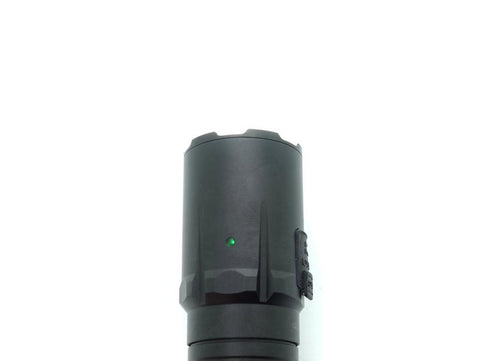
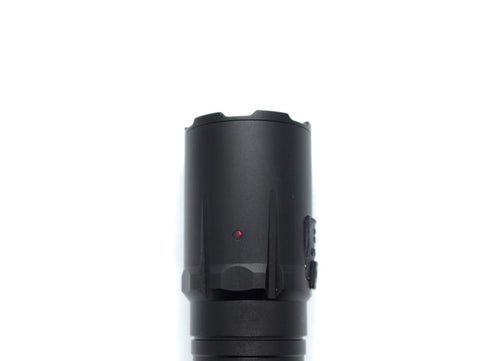
The LED displays the following colour when the torch is on:
|
Colour |
Battery level |
|
Green |
Power ≥ 70% |
|
Orange |
30% ≤ Power < 70% |
|
Red |
Power < 30% |
Low voltage protection
The torch switched off when the included battery reached 2.69V. The indicator LED will flash red when the battery is low. It is not clear whether the torch has LVP. I was not able to use an unprotected 21700 battery in this torch due to the proprietary connector.
PWM
I did not notice any visible PWM (flickering) while the torch was in use.
What I like about the UI
- Direct access to Turbo (Tactical)
- Direct access to Strobe (Tactical)
What could be improved
It would be nice if the Main and Mode switches on the remote switch behaved the same way as the Main and Mode switches on the tailcap so that you have more control over the light output. This would allow for the mode to be changed to High in the Outdoor group and it would be memorised.
Batteries and charging
Battery
A KLARUS 21700 5000mAh battery, model number 21GT-E50, was included inside the torch. The battery arrived with a voltage of 3.93V, and it was isolated with a piece of plastic.
The proprietary battery has both positive and negative contacts at one end. External chargers may not work with this battery due to the raisedblack plastic ring that may prevent a charger from touching the positive contact.
I managed to get the KLARUS 21GT-E50 battery to charge in one of my external chargers but it took a bit of fiddling to get it touch the positive end.
I was unable to get an unprotected flat top or a protected button top 21700 battery to work in the KLARUS GL4. It appears to require a proprietary KLARUS 21700 battery where both the positive and negative contacts are at one end.
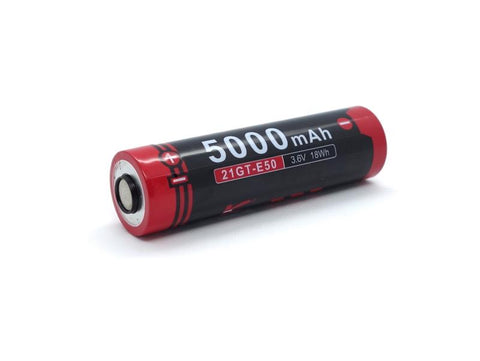
Charging
The indicator LED on the head of the torch is red while a battery is charging and it turns green when the battery is full.
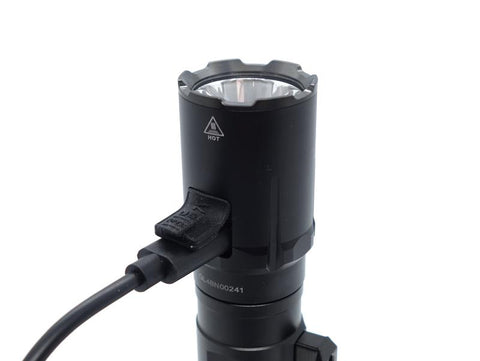
I discharged the included battery to 2.7V and used the built-in USB-C charger a few times. The built-in charger started charging the battery at 5V 0.1. It then increased to 5V 1.6A and gradually went back down to 5V 0.5A before stopping the charge at 4.14V.
4.14V is a little low to be considered fully charged but this is better for battery life.
Power supply compatibility
I tried the following power supplies with the KLARUS GL4’s built-in USB-C charger:
|
Power supply |
USB Type |
Protocol |
Does it charge? |
|
Apple 61W Power Adapter |
USB-C |
PD |
Yes |
|
Google Pixel Power Adapter |
USB-C |
PD |
Yes |
|
Generic 5V 2.4A Power Adapter |
USB-A |
|
Yes |
USB-C to USB-C works.
Performance
Specifications from the manual:
|
Category |
Turbo |
High |
Medium |
Low |
Strobe |
|
Output (lm) |
3,300 |
1,200 |
200 |
10 |
3,300 |
|
Runtime (h) |
4 |
7 |
13.5 |
375 |
|
|
Candela (cd) |
34,240 |
10,000 |
1,600 |
100 |
|
|
Range (m) |
370 |
200 |
80 |
20 |
|
Lux Meter: UNI-T UT383BT
DMM: UNI-T UT139C has been used to measure current under 10A
Lumen measurements
|
Mode |
Specs |
Lumens @turn on |
Lumens @30 sec |
Lumens @10 min |
|
Low |
10 lm |
10 lm |
6 lm |
6 lm |
|
Medium |
200 lm |
251 lm |
246 lm |
245 lm |
|
High |
1200 lm |
1134 lm |
1119 lm |
636 lm |
|
Turbo |
3300 lm |
2402 lm |
2315 lm |
995 lm |
Parasitic drain
There is going to be some amount of parasitic drain due to the electronic switches used. Normally I would attach a digital multimeter in series with the battery while the torch is off to see if there is any current. However, I was unable to easily attach probes to the proprietary battery connector down the tube.
Runtime graphs
I built a lumen tube and forked bmengineer’s project RuTiTe to add support for a VEML7700 light sensor and MCP9808 temperature sensor with help from Owen. Calibration lights from maukka were used.
Note: Lumen measurements may be off by more than 10% with my DIY lumen tube.

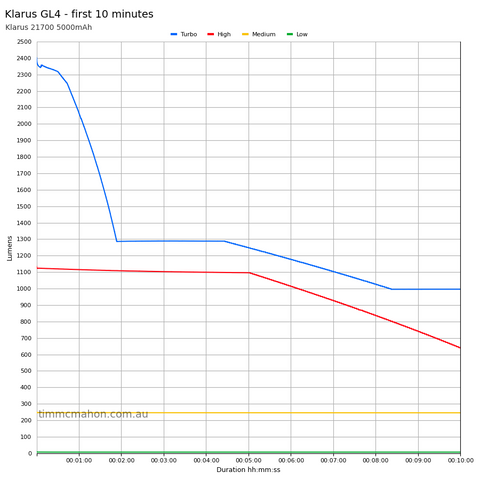
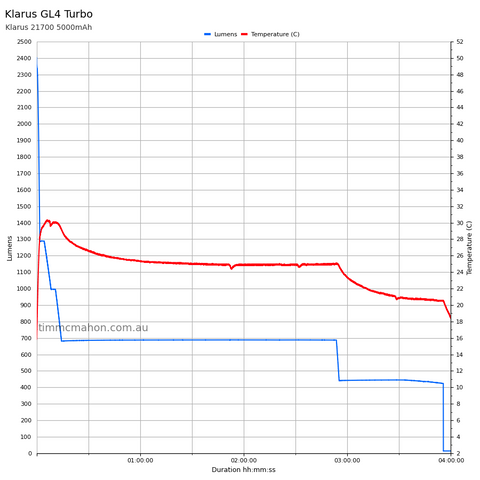
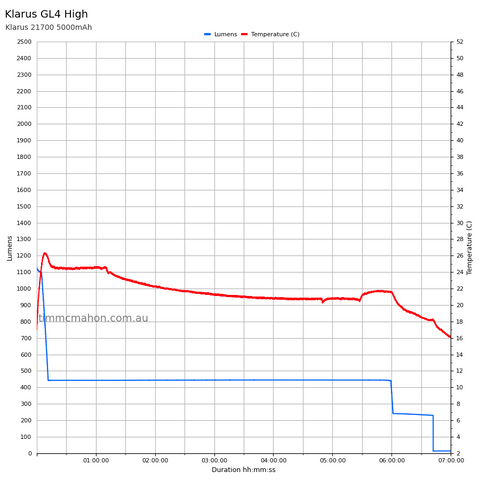
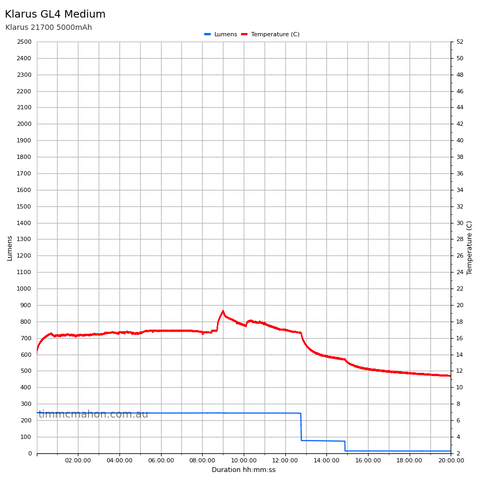
I charged the included battery to 4.19V in an external charger before each runtime test.
I stopped recording at 4 hours for Turbo, 7 hours for High, 20 hours for Medium and 10 minutes for Low. The torch kept running with a very low output for hours after I stopped recording. I only tested Low for 10 minutes because it is estimated to run for over six days.
The battery was 3.07V after 4 hours on Turbo and indicator LED was flashing red.
Turbo started at 2402 lumens, dropped to 1287 lumens at 2 minutes, dropped to 995 lumens at 8 minutes 24 seconds, dropped to 680 lumens at 14 minutes 27 seconds, dropped to 440 lumens at 2 hours 55 minutes, and finally dropped to 13 lumens at 3 hours 55 minutes. The maximum of 2402 lumens is lower than the specifications (3,300 lumens) but the runtime of 4 hours fairly accurate.
High started at 1134 lumens, dropped to 441 lumens at 11 minutes 49 seconds, maintained that output level for almost 6 hours, dropped to 240 lumens at 6 hours 1 minute, and finally dropped to 13 lumens at 6 hours 42 minutes. The maximum of 1134 lumens is fairly similar to the specifications (1,200 lumens) and the runtime of 7 hours is fairly accurate.
Medium started at 251 lumens, dropped to 76 lumens at 12 hours 46 minutes, and finally dropped to 13 lumens at 14 hours 53 minutes. The maximum of 251 lumens is slightly higher than the specifications (200 lumens) and the runtime of almost 15 hours is slightly longer than the specifications (13.5 hours).
Each mode can continue to run for several hours at 13 lumens. This feature can help you get home rather than leave you stranded in the dark without a functioning torch.
I would love to see KLARUS add a breakdown of the runtime in their future specifications so that people can see how Turbo steps down over time rather than assuming that it might last for 4 hours at 3,300 lumens. For example: 3300-1300-1000-400 lm, 2min-6min-6min-3h.
Overall, the light output appears to be well regulated and 680 lumens on Turbo for almost 3 hours is decent for this relatively small torch.
Throw
I took lux measurements with a UT383BT at 30 seconds for each mode. Turbo, High and Medium modes were measured at five metres while Low was measured at two metres.
|
Mode |
Specs (cd) |
Specs (m) |
Candela measured (cd) |
Distance (m) |
|
Low |
100 |
20 |
48 |
13 |
|
Medium |
1,600 |
80 |
2,325 |
96 |
|
High |
10,000 |
200 |
13,175 |
229 |
|
Turbo |
34,240 |
370 |
35,400 |
376 |
The KLARUS GL4 performed slightly better than expected in terms of beam intensity how far the beam can reach.
Beamshots
5000K WB, 3.2" shutter speed, ISO 100
Low
Medium

High
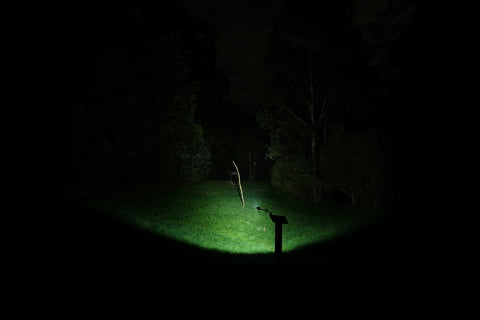
Turbo

Conclusion
This is the first time that I have used a tactical torch that has been designed to be used with a rail. I usually attach a torch to a rifle using a scope clamp. Figuring out how to attach this torch to a rifle without a rail was a fun challenge!
It was easy to attach the KLARUS GL4 to a rifle once I had a rail to attach to. A swivel stud to picatinny rail adapter got the job done but it would be better to use this torch on a rifle with a chassis system or where a rail runs parallel to the barrel so that the beam is pointing directly at a target.
I would be more inclined to recommend this for law enforcement or the military rather than hunters (unless hunters have a nice setup with a chassis system).
Pros:
- Excellent build quality.
- Good regulation.
- Simple user interface.
- USB-C to USB-C charging.
Cons:
- Remote switch is limited to Turbo mode.
- Proprietary battery required.
- Low CRI.
Product page
Product page
KLARUS at liteshop.com.au

